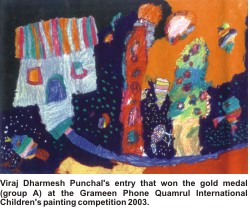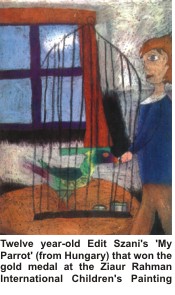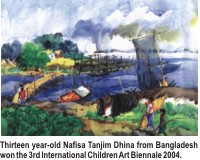Perceptions
Art as Part of Life's Education
Samina Nafies
 Child
art has universal appeal. It is the rhyme that comes from
the inner heart of a child. It is an open window, the social
reflection of a nation. Child art also reflects the political
and economic scenario of a country. Where an experienced eye
evolves in deep philosophical thinking by observing something,
in that same case a child draws the matter in his simple and
straight eye without much thinking. This easy and free imagination
has inspired many famous artists. Child
art has universal appeal. It is the rhyme that comes from
the inner heart of a child. It is an open window, the social
reflection of a nation. Child art also reflects the political
and economic scenario of a country. Where an experienced eye
evolves in deep philosophical thinking by observing something,
in that same case a child draws the matter in his simple and
straight eye without much thinking. This easy and free imagination
has inspired many famous artists.
We
know that every child is born with an inner creativity. This
creativity should be explored as it can be the key to his
self-reliance. The hidden talents of a child are developed
only through the proper implementation of his imagination
and merit and flourishes through drawing and painting. This
in turn influences the mental development of the child.
Child
arts has been given much importance in the West. Kerschenstien
was a leader of the German educational system but in art education
he had no influence. In his long working life of 22/23 years
he published a book named Art of the Children (1928).
After the First World War in 1922 GF Hutler published another
book named Child Creativity.
After
the First World War child art thrived in the West with schools
introducing art as a core subject. In 1938, London's Country
Hall first arranged a child art exhibition. Research shows
that by drawing, a child consciously or subconsciously learns
a lot of things. He develops his mental faculty and on the
other hand the subject matter of drawing fascinates him towards
the outside world. For example, he learns to love nature,
he feels for the animals, etc, and identifies with the various
aspects of life. In this way a child grows up and becomes
a complete individual. By drawing pictures, a child becomes
familiar with many aspects of life which would not have been
possible by merely reading books.
 Another
research shows that the child who draws pictures in his childhood
shows better performance in the long run and his experience
of drawing helps him in every profession and makes him more
skilled and creative. So in developed countries drawing is
a compulsory subject in pre-school education. Another
research shows that the child who draws pictures in his childhood
shows better performance in the long run and his experience
of drawing helps him in every profession and makes him more
skilled and creative. So in developed countries drawing is
a compulsory subject in pre-school education.
Every
child possesses an individual, independent personality and
has a specific view of life, which he draws from using his
own imagination. Drawing is a fun way for children to express
their emotions and communicate with others. A child should
be treated individually taking into account his nature, mental
development, etc. In a classroom environment, it should be
kept in mind that every child should get equal assistance
and at the same time the teacher should not interfere with
the piece of a drawing of a child. Mark Twain said that what
a person thinks about himself determines his own future.
In
developed countries child art has a strong influence and children
learn drawing before learning their alphabets.
The
art movement in Bangladesh began in 1948 and was pioneered
by Zainul Abedin. He realised that child art was equally important.
Though in our art movement we have faced a lot of social and
religious obstacles it was ultimately established by some
prominent artists like Kamrul Hasan, Shafiuddin Ahmed, Anwarul
Huq, Shafiqul Amin etc. Child art flourished thanks to founder
Director of Kachi Kanchar Mela late Roqunuzzaman Khan Dadabhai.
Kachi
Kanchar Mela was established in 1955. In 1958 it first established
an art school for children named Shilpobitan, now a very popular
institution for children. Shilpacharya Zainul Abedin was the
advisor of that school. In 1960 in the Art Institute a child
art school was established. In the Pakistan era most of the
branch offices of Pakistan Council (the then Charukola college)
used to arrange child art exhibitions and competitions. In
1976 Bangladesh Shishu Academy was established to develop
the inner talents of children. Today it has branches in 64
districts.
 To
create more awareness about child art, artist Hashem Khan
with some other art experts arranged two art workshops for
children. During that time Shishu Academy published a booklet
relating to the style and method of child art. With the help
of Bangladesh Shishu Academy the first Children's Art Competition
was held in 1982 which was known as Ziaur Rahman International
Children Art Competition. In 1998, Shishu Academy launched
a Biennale International Children Art Competition and another
one in 2000. Through this competition, children from different
countries had the opportunity to expose their talents and
child artists of Bangladesh were also recognised internationally. To
create more awareness about child art, artist Hashem Khan
with some other art experts arranged two art workshops for
children. During that time Shishu Academy published a booklet
relating to the style and method of child art. With the help
of Bangladesh Shishu Academy the first Children's Art Competition
was held in 1982 which was known as Ziaur Rahman International
Children Art Competition. In 1998, Shishu Academy launched
a Biennale International Children Art Competition and another
one in 2000. Through this competition, children from different
countries had the opportunity to expose their talents and
child artists of Bangladesh were also recognised internationally.
The
effort to promote child artists continues. Gandaria Kisholoy
Kachi Kanchar Mela Dhaka arranges International Art exhibitions
every two years in remembrance of Zainul Abedin and Quamrul
Hasan. This year 23 countries participated. Bangladesh Shishu
Academy is also organising the Biennale International Children
Art Competition for the third time this year. In the last
two competitions, 12 countries participated in 1998 and 16
countries in 2000.
But
this year 34 countries have participated. The participating
countries were from Asia, Europe, Africa and North America.
From there 13,910 paintings were received and 658 were selected
for the exhibition. Thirteen-year-old Nafisa Tanjim Dhima
from Bangladesh won the Grand Prix Prize.
Today
in our society finding pure talent is not easy and it is our
moral obligation to encourage our children so that they can
develop their creative skills. An open dialogue should be
exchanged and workshops should be arranged for the instructors
and parents. The instructor who teaches the children about
art should be properly trained. Art as an essential part of
children's education should be promoted.
The
writer is Programme Officer, Bangladesh Shishu Academy.
Copyright
(R) thedailystar.net 2004
| 